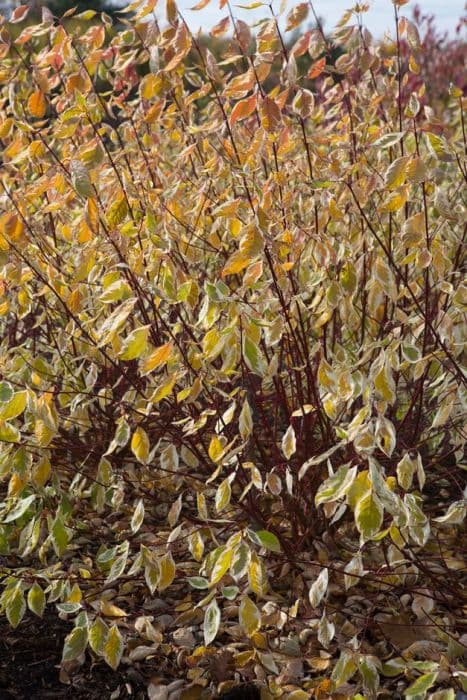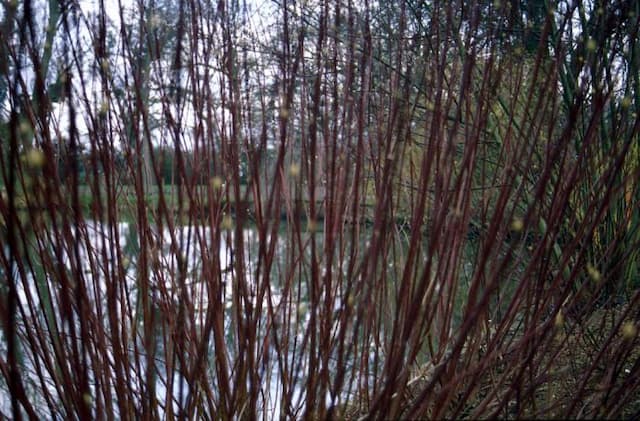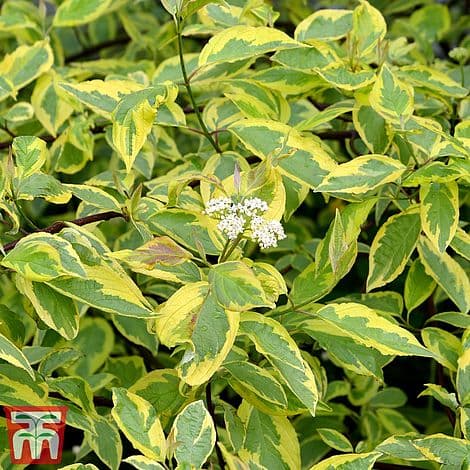Kousa Dogwood Cornus kousa 'Summer Fun'











ABOUT
The 'Summer Fun' is a variety of Kousa dogwood known for its striking appearance. It features a distinctive variegated foliage, which includes leaves edged with creamy white to yellow margins, encompassing a green center. This gives the plant a bright and lively appearance that stands out in the landscape. In the spring, it blooms with star-shaped flowers, which are actually modified leaves called bracts. These bracts start off as a greenish color before turning to a pristine white, creating a showy display. As the season progresses, the bracts may develop hints of pink. After the flowering period, the Summer Fun produces berry-like fruits that could attract birds and wildlife. The fruits are typically red to pink in color and resemble raspberries. Additionally, the bark on the Kousa dogwood is exfoliating, giving the trunk and branches a mottled appearance with a mixture of tan, gray, and brown shades, adding interest to the winter landscape when leaves have fallen.
About this plant
 Names
NamesSynonyms
Chinese Dogwood, Kousa Dogwood, Japanese Dogwood, Korean Dogwood.
Common names
Cornus kousa 'Summer Fun'.
 Toxicity
ToxicityTo humans
The plant commonly known as Kousa dogwood is not known to be poisonous to humans. In fact, the fruit of the Kousa dogwood is edible and is sometimes used to make wine or jelly. However, it is important to note that consuming any plant material may cause a reaction in sensitive individuals, so it's recommended to try a small amount if you're consuming it for the first time. There are no common symptoms of poisoning associated with the Kousa dogwood because it is not considered toxic to humans.
To pets
The Kousa dogwood is also not considered toxic to pets. The fruit may be safely consumed by dogs and other domestic animals without the risk of poisoning. As with any non-traditional food, moderation is key, and pet owners should watch for any adverse reactions if their pet has ingested part of this plant for the first time, such as an upset stomach or an allergic reaction. There are no specific toxicity symptoms to pets reported for this plant.
 Characteristics
CharacteristicsLife cycle
Perennials
Foliage type
Deciduous
Color of leaves
Variegated
Flower color
White
Height
15-20 feet (4.5-6 meters)
Spread
15-20 feet (4.5-6 meters)
Plant type
Tree
Hardiness zones
5-8
Native area
Asia
Benefits
 General Benefits
General Benefits- Ornamental Appeal: Cornus kousa 'Summer Fun' boasts variegated foliage and a showy flower display, contributing to the aesthetic value of landscaping.
- Seasonal Interest: This variety offers multi-season interest with spring flowers, summer berries, and vibrant fall foliage.
- Drought Tolerance: Once established, it is relatively tolerant to drought, reducing the need for frequent watering.
- Pest and Disease Resistance: It is known for being resistant to many common pests and diseases, minimizing the need for chemical treatments.
- Wildlife Attraction: The berries produced can attract birds and other wildlife, contributing to biodiversity in the garden.
- Low Maintenance: The plant has minimal pruning and care requirements, making it suitable for gardeners of all levels.
- Adaptability: It can adapt to a range of soil conditions, though it prefers well-draining, fertile soil.
- Cold Hardiness: It has a good tolerance for cold temperatures, making it suitable for planting in cooler climates.
 Medical Properties
Medical Properties- This plant is not used for medical purposes.
 Air-purifying Qualities
Air-purifying QualitiesThis plant is not specifically known for air purifying qualities.
 Other Uses
Other Uses- Culinary ingredient: The fruit of Cornus kousa 'Summer Fun', also known as Kousa dogwood, can be eaten fresh, made into puddings or jams, or fermented into wine.
- Creative craft material: The tree's branches and twigs can be used in floral arrangements or as framework for wreaths and other decorative items.
- Dye production: The bark of Kousa dogwood has been used historically to produce dyes for textiles.
- Ink component: Similar to the dye properties, the bark and fruit can be boiled down to create a natural ink for artistic purposes.
- Fabric printing: Leaves and fruits can be used in nature printing techniques to create patterns on fabric or paper.
- Photography: The distinctive patterns and structure of the leaves and flowers are popular subjects for photography, especially close-up and macro photography.
- Animal feed: In some regions, the fruit is used as feed for wildlife or livestock, particularly birds and small mammals.
- Edible landscape design: The tree can be a focal point in an edible landscape garden, providing both aesthetic beauty and food.
- Woodworking: Though not a large tree, Cornus kousa wood can be used for small woodworking projects like tool handles or intricate carving.
- Festive decoration: During holidays, the berries and branches can be used to create festive decorations or centerpieces.
Interesting Facts
 Feng Shui
Feng ShuiThe Kousa Dogwood is not used in Feng Shui practice.
 Zodiac Sign Compitability
Zodiac Sign CompitabilityThe Kousa Dogwood is not used in astrology practice.
 Plant Symbolism
Plant Symbolism- Strength and Durability: The Cornus kousa, also known as Kousa Dogwood, has a reputation for being hardy and resilient, which lends itself to symbolize strength and the ability to withstand life's challenges.
- Beauty and Elegance: With its attractive flowers that bloom in spring and summer, the Kousa Dogwood represents beauty, grace, and the elegance of the natural world.
- Renewal and Hope: As a plant that flowers in the warmer months, it signifies rebirth and new beginnings, offering hope for the future.
- Purity: The pristine white flowers of the Kousa Dogwood are often associated with purity and innocence.
- Christian Symbolism: In Christian symbolism, the dogwood is said to be associated with the crucifixion of Jesus, thus symbolizing faith, sacrifice, and resurrection.
 Water
WaterKousa dogwood 'Summer Fun' should be watered deeply once a week during its growing season, especially if the weather is dry. Ensure the water penetrates the soil to a depth of about 6 inches. In hot, dry periods, increase watering to twice per week. During winter, reduce watering as the tree is dormant and its water requirements decrease. It's important not to overwater, as this can lead to root rot. Generally, provide about 5 gallons per week during active growth, adjusting for precipitation and soil moisture levels.
 Light
LightThe Kousa dogwood 'Summer Fun' thrives in full sun to partial shade. The ideal spot for this tree offers morning sunlight with some afternoon shade, particularly in hotter climates. Avoid deep shade, as this will hamper its flowering and can lead to a weaker plant.
 Temperature
TemperatureThe Kousa dogwood 'Summer Fun' prefers a temperature range between 60°F and 75°F for optimal growth, but it is quite adaptable and can withstand temperatures as low as 0°F and as high as 85°F. It is important to protect the plant from extreme temperatures either way, as prolonged exposure outside this range can stress the tree.
 Pruning
PruningKousa dogwood 'Summer Fun' is pruned to maintain its shape, remove any dead or diseased wood, and encourage healthy growth. Pruning should be done in late winter or early spring before new growth starts. It's typically sufficient to prune this tree every two to three years, focusing on thinning out crowded branches to allow light and air into the canopy.
 Cleaning
CleaningAs needed
 Soil
SoilKousa dogwood 'Summer Fun' thrives in rich, well-draining soil with a mix of two parts loam, one part sand or perlite, and one part compost or peat. The ideal soil pH is slightly acidic to neutral, ranging from 5.5 to 7.0 for optimal growth and health.
 Repotting
RepottingKousa dogwood 'Summer Fun' is typically grown outdoors and does not require repotting. However, if grown in containers, repot every 2-3 years to replenish soil nutrients and provide space for growing roots.
 Humidity & Misting
Humidity & MistingKousa dogwood 'Summer Fun' prefers moderate humidity levels consistent with outdoor conditions. It is adaptable but does well in average ambient humidity without the need for special adjustments.
 Suitable locations
Suitable locationsIndoor
Not ideal for indoor growth; requires sun and space.
Outdoor
Plant in partial shade to full sun, water regularly, well-draining soil.
Hardiness zone
5-8 USDA
 Life cycle
Life cycleCornus kousa 'Summer Fun', commonly known as Kousa Dogwood, begins its life cycle as a seed, which after stratification germinates in the spring. Once germinated, the seedling emerges and starts to grow, developing a root system and foliage. The plant enters a vegetative stage where it focuses on leaf and branch growth, typically maturing over several years before it starts flowering. After reaching maturity, Kousa Dogwood produces showy flowers in late spring to early summer, which after pollination develop into pinkish-red fruit. The fruits, when mature, drop to the ground, potentially giving rise to new seedlings, thus continuing the cycle. During winter, the plant goes dormant, shedding leaves, and conserving energy to repeat the cycle in spring.
 Propogation
PropogationPropogation time
Early Spring
The Cornus kousa 'Summer Fun', commonly known as Kousa dogwood, is typically propagated by softwood cuttings taken in late spring through early summer. This method involves selecting healthy, non-flowering stems of the current year's growth. These stems should be 4 to 6 inches (10 to 15 centimeters) long and contain a few leaves. The bottom end of the cutting is usually dipped in rooting hormone to encourage root development and then planted in a pot with well-draining soil. The cuttings should be kept moist and in a warm, indirect light environment until they root, which can take several weeks. Once rooted, the new plants can be gradually acclimated to outdoor conditions before being transplanted into the garden.









